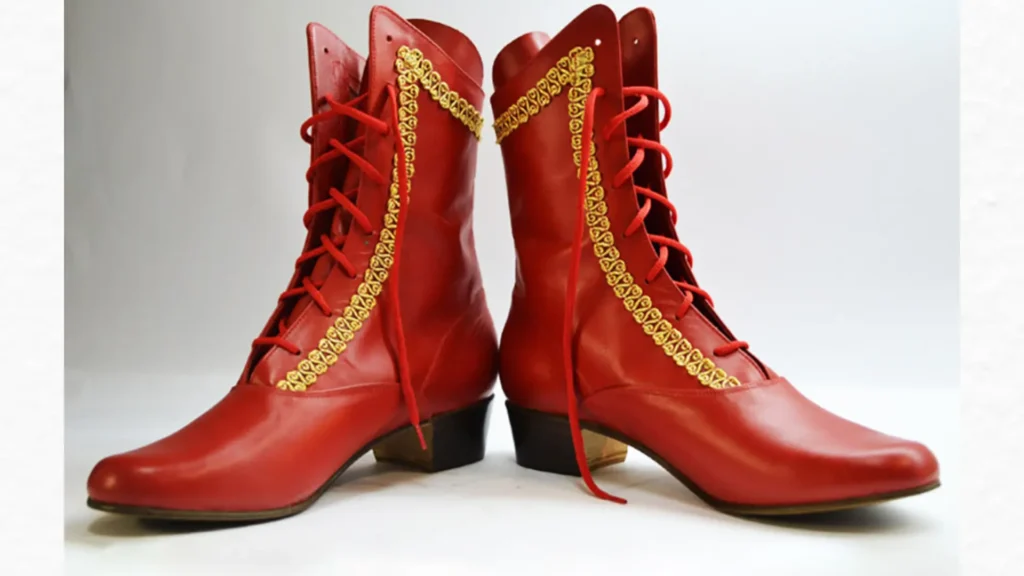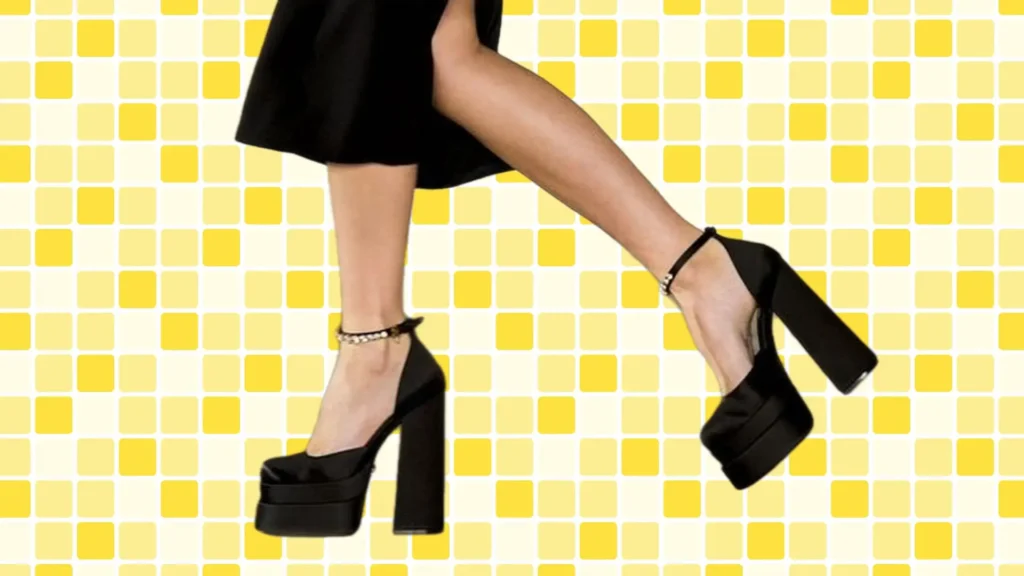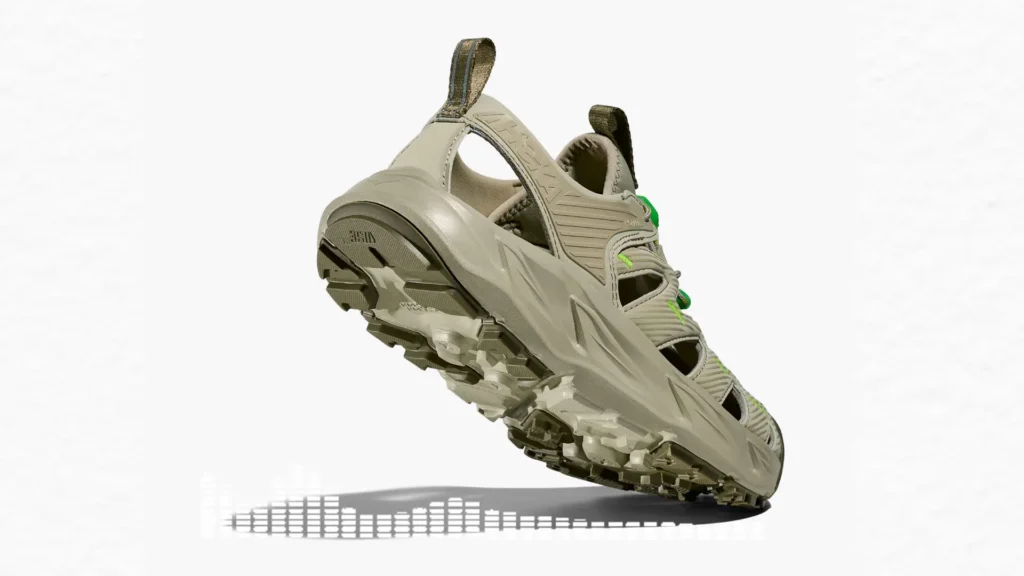Imagine stepping into a vibrant Russian folk dance, where every stomp and twirl tells a story of culture and history.
The footwear on the dancers’ feet is not just a practical choice—it’s a vital part of the performance, steeped in tradition and purpose. In Russian folk dance, shoes shape the movements, reflect regional identities, and connect dancers to centuries-old customs.
Traditional Footwear in Russian Folk Dance
Russian folk dance footwear is as diverse as the country’s vast landscapes. For centuries, peasants wore lapti, woven shoes made from bast, the fibrous inner bark of trees.
These lightweight, affordable shoes were common in rural areas and appear in folk dance performances to evoke historical authenticity. Lapti are typically paired with onuchi, cloth wraps that secure the shoes and protect the feet.
In urban settings and among wealthier classes, leather boots dominated. These boots were made of colored leather, morocco, brocade, or velvet, sometimes adorned with embroidery and gems.
By the 17th century, nobility began adopting low-heeled shoes influenced by Western fashion, but boots remained a staple for folk dance due to their durability and support.
Valenki, felt boots made from compressed wool, are another traditional choice, especially for winter performances. These boots are warm but not waterproof, so they’re worn with galoshes for protection. Valenki are less common in dynamic dances but are used in slower, ceremonial performances to represent rural life.
For modern folk dance troupes, character shoes—specialized leather boots designed for stage performances—are popular. These include red boots for men and women, used in Kalinka or Yablochko, and black leather boots for versatility across various styles.
These shoes are crafted to balance authenticity with the demands of theatrical performance.
The Significance of Red Boots
Red boots steal the spotlight in many Russian folk dance performances. The color red holds deep cultural meaning in Russia, symbolizing beauty, vitality, and joy. In folk costumes, red is the dominant hue, and boots in this vibrant shade amplify the visual impact of a dancer’s movements.
Red boots are especially prominent in Cossack dances and the lively Yablochko, where they emphasize the energy and precision of fast footwork.
Historically, red boots were a status symbol. While peasants wore simple lapti, wealthier individuals could afford dyed leather boots, with red being a popular choice for its bold aesthetic. In dance, these boots connect performers to this heritage, signaling both tradition and prestige.
Their bright color also draws the audience’s eye, highlighting intricate steps and adding flair to group formations.
In modern performances, red boots are custom-made for stage use. They’re designed to be lightweight yet sturdy. They allow dancers to execute high kicks and spins without sacrificing comfort. The striking hue ensures that every movement is visually captivating, making red boots a powerful tool for storytelling through dance.
Footwear’s Influence on Prisiadki
Prisiadki is the iconic squat dance of Russian and Ukrainian traditions.
This low, squatting move, where one leg is thrust out while the other supports the body, requires footwear that offers flexibility, support, and traction. The right shoes can make or break a flawless prisiadki performance.
Leather boots, commonly used in Kozachok or Barynya, provide ankle support and a firm sole for stability during rapid squats and kicks. Their structure allows dancers to maintain balance while performing the demanding crouching and thrusting motions.
The soles are designed with slight heels or textured surfaces to prt slipping, crucial for the quick, forceful steps of prisiadki.
Lapti are less ideal for prisiadki due to their soft, woven construction, which lacks the rigidity needed for such vigorous movements. However, in historical reenactments, dancers wear lapti for authenticity, relying on their skill to compensate for the lack of support.
Valenki, being bulky and soft, are rarely used for prisiadki, as they hinder the precision required for this move.
Character shoes, with their tailored fit and reinforced soles, are the modern choice for professional troupes. These shoes enhance the dancer’s ability to execute prisiadki’s low squats and explosive jumps. The design ensures dancers can focus on the rhythm and energy of the dance without worrying about their footwear failing them.
Materials Used in Traditional Russian Dance Shoes
The materials of Russian folk-dance shoes reflect both practicality and cultural heritage. Lapti are crafted from bast, typically from linden, birch, or willow bark. These natural fibers are abundant, lightweight, and easy to weave, making lapti an economical choice for peasants.
However, they wear out quickly, lasting only a week or two, especially in wet conditions. To increase durability, some lapti feature leather soles or straps.
Leather boots, used in more formal or urban dances, are made from soft, dyed leather, morocco, or brocade or velvet for nobility. These boots are treated with tar or fish oil to enhance water resistance and durability, essential for outdoor performances. Leather provides flexibility and support.
Valenki are made from felted wool, compressed into a thick, warm material perfect for cold climates. While not waterproof, they are paired with rubber or leather soles for added protection. Valenki’s soft, cushioned structure offers comfort but limits their use in fast-paced dances.
Modern character shoes combine traditional aesthetics with contemporary materials. They use high-quality leather for durability and flexibility, with reinforced soles and heels to support dynamic movements. Some include synthetic linings for comfort during long performances, blending old-world style with modern functionality.
These materials are chosen for their availability, affordability, and ability to meet the physical demands of dance. Bast and leather are rooted in Russia’s natural resources and historical crafting techniques, while modern additions like synthetic linings reflect advancements in footwear technology.
Regional Variations in Russian Dance Footwear
Russia’s vast size and diverse cultures result in regional differences in dance footwear. In Central Russia, lapti are woven with diagonal bast patterns, starting from the heel, and feature high ankle designs for extra support. Moscow lapti are known for their high ankle bumpers and rounded toes, ideal for structured dances.
In the North, lapti are lower with pointed toes, suited for lighter, more agile movements. Winter lapti in this region may have double-layered bast or leather soles for warmth and durability.
Western Russia starts weaving lapti from the toe with a crosswise pattern, creating a distinct look and fit. These shoes are lighter, allowing for faster footwork in Kamarinskaya.
In Kursk province, straw lapti are used, which are stronger and more resistant to moisture and freezing, making them suitable for outdoor performances in harsh climates. Novgorod Province is famous for its intricate lapti designs, made from linden or birch bark with woolen ribbons for festive dances.
Valenki are more common in colder regions, where their warmth is essential for winter performances. Leather boots, especially red ones, are prevalent in Cossack regions for their bold appearance and suitability for high-energy dances.
These variations reflect local resources, climate, and dance styles, ensuring footwear meets both practical and cultural needs.
Historical Origin of Lapti
Lapti, the iconic bast shoes, have been worn since prehistoric times, with evidence of wooden lasts used to shape them found in Neolithic excavations dating back 4,900 years.
Originating in Northeastern Europe, lapti were made from bast fibers of linden, birch, or willow trees, which were plentiful in forested areas. Their simple weaving process made them accessible to peasants, who could craft them at home using basic tools.
In Russian folk dance, lapti became a symbol of peasant life. They were cheap, costing about three kopecks compared to five rubles for leather boots, but wore out quickly, requiring frequent replacements.
Lapti were worn with onuchi and secured with straps, providing a snug fit for dancing. Their cultural significance extended beyond practicality—they were believed to ward off evil spirits and were used to transport house spirits during moves.
During the Soviet era, lapti were mass-produced for the Red Army during the Civil War. However, as leather and rubber shoe production grew, lapti became less common, relegated to folk performances and souvenirs by the 20th century.
Evolution of Russian Folk Dance Footwear
Over centuries, Russian folk-dance footwear has evolved from simple peasant shoes to specialized performance gear. In ancient times, lapti were the primary footwear, woven from bast for affordability and ease of production.
By the 14th century, leather boots emerged in towns, offering greater durability and style, especially among the nobility. These boots featured decorative elements.
In the 17th century, Western influences introduced low-heeled shoes, but boots remained dominant in folk dance for their support. The 18th century saw military reforms under Peter the Great, standardizing boots for soldiers, which influenced dance footwear with practical, softer designs.
The 19th century brought valenki, felt boots that gained popularity in colder regions. Their warmth made them ideal for winter performances, though their bulk limited their use in fast dances. By the 20th century, industrialization led to mass-produced leather and rubber shoes, phasing out lapti for everyday use.
Today, professional folk dance troupes use character shoes, combining traditional leather with modern reinforcements for enhanced performance. These shoes maintain the aesthetic of historical footwear while meeting the demands of rigorous stage routines. Lapti and valenki persist in ethnographic performances, preserving their cultural legacy.
Shoes for Male and Female Dancers
In traditional Russian folk dance, men and women wear similar footwear, with some distinctions based on style and function.
Lapti are unisex, as they were shaped on a single last, making no difference between left and right or male and female feet. Both genders wear them with onuchi for a secure fit, though women’s lapti may feature decorative ribbons for festive dances.
Leather boots, particularly red or black ones, are also worn by both men and women. Men’s boots are slightly wider and sturdier to support more vigorous movements, while women’s boots may be more tapered for a refined look.
In Cossack dances, men typically wear red boots to emphasize their bold, acrobatic steps, while women may wear matching boots or lighter character shoes for intricate footwork.
Valenki are less common but used by both genders in colder climates, with no significant gender-specific design differences. Modern character shoes are tailored to fit each dancer’s foot precisely, with men’s shoes having broader soles and women’s featuring slimmer profiles to enhance elegance.
These differences ensure that footwear complements the distinct roles men and women play in dances while maintaining a unified cultural aesthetic.
Design Enhancements for Performance and Safety
The design of Russian folk dance shoes is carefully crafted to boost performance and ensure safety. Lapti are lightweight and breathable, allowing for agile movements, but their soft soles require skilled dancers to avoid slips. Leather straps or soles add stability, reducing the risk of ankle injuries during spins or jumps.
Leather boots provide ankle support and a firm sole, crucial for high-impact moves. Their treated leather surfaces offer water resistance and durability, protecting feet during outdoor or prolonged performances. The slight heel aids in maintaining posture during complex steps.
Valenki offer cushioning and warmth, ideal for winter shows, but their soft structure requires careful foot placement to prevent missteps.
Modern character shoes are the pinnacle of performance design, with reinforced toes and heels to withstand repetitive impacts, flexible leather for ease of movement, and non-slip soles for safety on stage. Their precise fit minimizes blisters and fatigue, allowing dancers to perform longer.
These design elements ensure dancers can execute challenging moves with confidence, reducing the risk of injuries while enhancing the visual and technical quality of the performance.
Footwear in Russian folk dance is more than a practical necessity—it’s a bridge to history, culture, and artistry. From the humble lapti to the vibrant red boots, each type of shoe tells a story of tradition and adaptation. These shoes shape the execution of iconic moves, reflect regional diversity, and evolve with time while staying rooted in Russia’s rich heritage.




